
Patient confidentiality is a fundamental principle in healthcare. Patients entrust medical professionals with their most personal and sensitive information, such as medical histories, diagnoses, and treatment details. They are breaching this confidentiality with severe consequences to professional reputations and erosion of trust between patients and healthcare providers.
Self-deleting online notes
Self-deleting online notes are digital messages or notes that delete themselves after a predetermined time. These notes are designed to be temporary sensitive information that remains accessible only for a limited period and disappears, leaving no trace behind.
Online notes enhance patient data confidentiality
Controlled access and sharing
The primary benefit of self-deleting online notes is controlling who accesses sensitive patient information and for how long. Healthcare professionals share confidential details with authorized individuals or teams while setting a time limit for the note’s availability. Once the time limit expires, the note self-destructs, ensuring the information is accessed or misused.
Reduced risk of data breaches
Data breaches are a significant concern in the healthcare industry, exposing patients’ personal and medical information to unauthorized parties. Self-deleting online notes minimizes data breaches by limiting the window of opportunity for unauthorized access. Since the notes self-destruct after a predetermined data theft or exposure time, it is significantly reduced.
Enhanced compliance and regulatory adherence
The healthcare industry is subject to strict regulations and compliance requirements regarding patient privacy and data protection, such as the Health Insurance Portability and Accountability Act (HIPAA). By using self-deleting online notes, healthcare organizations demonstrate their commitment to safeguarding patient data and ensuring compliance with relevant regulations, reducing the risk of legal liabilities.
Implementing self-deleting online notes in healthcare
Identifying sensitive patient information
The first step in implementing self-deleting online notes is to identify the types of sensitive patient information that require additional security measures. This may include medical records, test results, treatment plans, or any other personal or health-related data that could compromise patient privacy if exposed Write your notes online.
Choosing a secure and reliable platform
Select a self-deleting online notes platform that prioritizes security and privacy. Look for providers with robust encryption, access controls, and reliable self-destruct mechanisms. Ensure that the platform complies with relevant healthcare regulations and industry standards.
Establishing access controls and time limits
Once you have chosen a secure platform, establish access controls and time limits for sensitive patient information. Determine who needs access to the information and for how long. Set appropriate time limits for the notes to self-destruct, ensuring the data is only available for the intended duration and purpose.
Training and awareness
Educate healthcare professionals and staff members on the importance of patient data confidentiality and the proper use of self-deleting online notes. Provide training on best practices for handling sensitive information and the potential consequences of unauthorized disclosure or misuse.
Regular audits and monitoring
Regularly audit and monitor self-deleting online notes within your healthcare organization. Ensure access controls and time limits are followed, and promptly address any potential security concerns or incidents.
To maximize the effectiveness of self-deleting online notes, integrate them into existing workflows and communication processes within your healthcare organization. Encourage using these notes to share sensitive patient information during consultations, team discussions, or collaborative care efforts.
